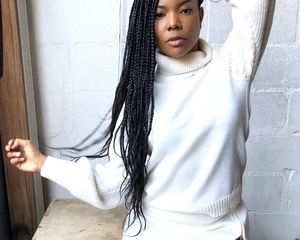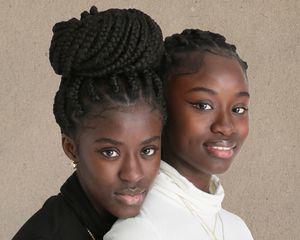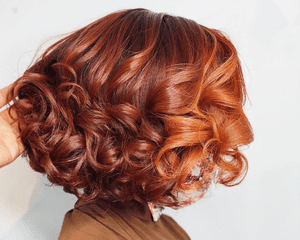:max_bytes(150000):strip_icc()/ScreenShot2022-12-14at4.11.11PM-020893b2063b4845aee2ad3c6ced2ac3.png)
@OFFICIALLISABONET / Design by Dion Mills
Once you decide to embark on the beautiful journey of getting locs, it's easy to feel confused on where to start and what each step of the process entails. There are five different stages of locs and each stage requires different maintenance and care.
Five Stages of Locs
- Starter
- Budding
- Teen
- Mature
- Rooted
When you reach the rooted stage of your dreadlocks, the versatility in hairstyles that awaits you is endless but it takes some time to get there. The average loc journey can take 18-24 months so it's definitely a process that requires a lot of patience and upkeep.
If you're ready to commit to this hairstyle, then please read ahead as two master locticians breakdown every stage of the loc'ing process and arm you with tips and product recommendations to ensure that your loc journey will be as smooth as possible. Keep scrolling to get a full breakdown of the loc stages.
Meet the Expert
- Chimere Faulk is a natural hairstylist, loctician, and the founder of loc care brand Dr. Locs.
- Courtney Grayton is a master loctician, hair educator and the owner of Hair Goals, a hair salon in District Heights, Maryland.
How to Prep Your for Your Loc Journey
Courtney Grayton recommends having at least 3-4 inches of relatively healthy hair before setting up your loc appointment. "Though not absolutely necessary, it would be a great idea to get a professional trim as split ends are not able to accept and retain moisture properly," she adds.
Grayton also suggests doing hydration treatments such as a deep conditioning or a steam treatment to help give your hair extra moisture. This helps prepare your hair for the change in routine it's about go through.
Stage One - Starter Locs
:max_bytes(150000):strip_icc()/62102296_1035040696886414_2977847195613147692_n-f4a82208c4b742f38112936943199e8f.jpg)
The starter (aka "baby") stage of the loc process can last anywhere from three to six months, depending on your hair type and how fast it grows. There are several styles—such as braids, two-strand twists, comb coils, and palm rolls—that you can choose from to start your locs. This is the stage where you'll begin to create a parting pattern if you wish. You could also always opt for a free-form look, where you don't "cultivate" or control section size and simply allow your hair to be. Either way, it's important that you don't create sections that are too small, as locs can break off if they're too thin or too dry.
"In the starter stage, it may seem difficult because your hair keeps coming undone when shampooing," says Faulk. The length of this stage is entirely determined by your hair type and how fast your hair typically grows, but expect about three to six months. Your locs will look pretty uniform and neat. The best course of action during this stage? Just letting them grow.
Stage Two - Budding Locs
:max_bytes(150000):strip_icc()/59668461_152198512491265_317654383510548286_n-31c9e66b9109451ca6a644d3e0e9c573.jpg)
During the budding phase, you might notice that your new growth is puffy and on the fuzzy side. "During this stage, your hair will start to stick or matte together at the tops of your coils after shampooing," Faulk notes. However, it's still crucial that you are consistently and thoroughly cleansing your hair to avoid build-up, bumps, and weak spots.
It's a great idea to practice a re-twisting routine to maintain the style of locs you choose or to transition in loc sizing. You can keep track of the original section partings when re-twisting or maintaining a free-form style without parting. It allows you to get into a consistent routine while keeping up with the rapid growth process. This stage can last anywhere between six to 12 months.
Byrdie Tip
It may be tempting to re-twist often, but it's important not to overdo it, as this can lead to thinning locs and breakage that can prolong your loc growth.
Stage Three - Teenage Locs
:max_bytes(150000):strip_icc()/Willow-Smith-d143fce74aac4dab9d3673aed0f4640d.jpg)
Jacopo Raule / Getty Images
"The teenage stage feels fun because you start to see the vision," Faulk says. However, this is also the stage where you wonder what could be going on with your hair. Too short to lie down easily, your teenage locs may seem to sprout all over your head and go in whatever direction they want. This can be a tough stage for some, but if you can persevere, it'll be worth it.
Faulk explains: "Your locs start to plump up and develop their form. You want to be careful with product use before the next steps because of product build-up. This is also an excellent time to invest in and experiment with accessories such as scarves, headbands, and head wraps. They'll enable you to play around with different styles and jazz things up.
This stage can last anywhere from 12 to 15 months and again, you don't want to re-twist too much because it can cause damage to your hair.
Stage Four - Mature Locs
:max_bytes(150000):strip_icc()/60463593_203829600591146_396616618845716126_n-58575733cab84c659e15e5035d1d1535.jpg)
"The mature stage could begin as early as one year after beginning your journey depending upon the texture of your hair," Faulk tells us. Don't worry if you're over a year in and you don't feel your locs aren't mature yet, though; looser hair textures often take longer.
You know you've reached the mature stage (about 15 to 18 months) when your locs are finally long enough to lie flat or hang down. Faulk asserts that "maturing occurs when your locs are firm and there’s no more reforming," so you won't have to re-twist your new growth as often during this period. The locs should be thick enough to support themselves. Odds are you'll be comfortable with your locs by now, and able to enjoy a regular shampooing and conditioning routine.
Stage Five - Rooted Locs
:max_bytes(150000):strip_icc()/45634575_337621757033374_6334111456182368410_n-0374ce14450846038dd928dea3e83b61.jpg)
Once your locs are firmly in place, you're officially in the rooted or "adult" stage. "This stage comes several years later," Faulk makes a point of saying. "In the final stage, your locs will hang differently. They feel heavier and at the same time more slender." This will be around 18 to 21 months.
At this point, you'll be able to wear your locs well past your waist or trim them if you want a more manageable style. What's more: Your hair care routine can be as simple or as complex as you like, although Faulk emphasizes that "throughout each stage, you want to make sure you keep your locs hydrated."
If you're not comfortable with re-twisting or even choosing a starter loc hairstyle, you can always visit a professional loctician, who can guide you in the right direction.
Moisture Retention and Low-Manipulation Help You Maintain Healthy Locs
Grayton says that moisture retention and low-manipulation are key to helping you maintain healthy locs in each and every stage of your loc journey. "The tried-and-true way to moisturize your locs is through the “hydrate and seal” process. This involves using a water-based product to add hydration to the hair and then sealing that moisture in by applying an oil-based product on top."






